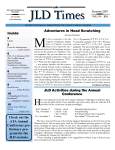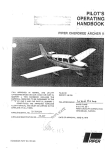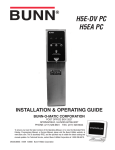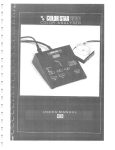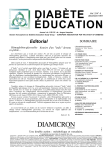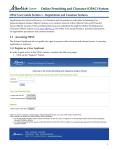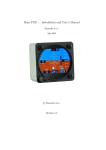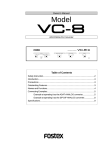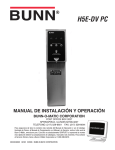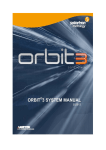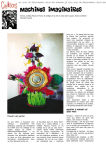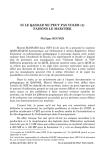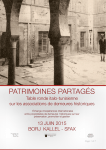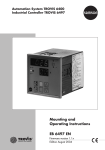Download pdf file available
Transcript
Essays of an Information Scientist, Vol:7, p.50-56, 1984 Current Contents, #8, p.3-9, February 20, 1984 I Number Sci-Mate 1.2: Improved Customer Services and a New Version of the Software for Personal Text Retrieval and Onliue Searclsfng Februarv ,. 20, 1984 8 Almost a year has passed since we announced lS1°’s new microcomputer software package, Sci-Mate ‘“.1 Briefly, Sci-Mate consists of two components: Text Manager (formerly the Personal Data Manager) and the the Personal Universal Online Searcher. The Persona[ Text Manager is a data base management system designed specifically to accommodate textual matenal—e~pecially bibliographic material. It allows scientists to keep tabs on reprints, correspondence, lab notes, and even patient records. The Universal Online Searcher allows users to search any of the hundreds of data bases mounted on several without large commercial vendors, learning any special command languages. Using both Sci-Mate components, one can ‘(offload” items reOnline trieved through the Universal (from data bases which permit Searcher downloading) for permanent storage in the Personal Text Manager. See the appendix following this essay for a summary of this software system’s principal features. (A revised version of the origidescription] is in preparanal Sci-Mate tion. This will take into account changes in the system. ) Enough time has now elapsed for us to evaluate our first venture into microhas been computer software. Sci-Mate well received by users, But even though we anticipated that providing support 10 customers would be an important factor in its success, we underestimated just how important it would be. If you’re one of those who has used a personal computer, surely you remember your first encounter with it. Who could forget the instruction manuaf’s “technogibberish”’ and the repeated error messages caused by seemingly minor mistakes? For the moment, 4’bootingup” a microcomputer is not as simple as plugging the electric cord into an outlet. Clearly, most people can quickly learn what is involved, but no thanks to the manuals generally provided. The fact is, like many hardware and software manufacturers, we at 1S1 overestimated scientists’ sophistication in the use of microcomputers. Although we expected to have some novice users, we underestimated the number of individuals who would buy their microcomputers Therefore, many just to use Sci-Mate, scholars were sitting down to their microcomputers for the first time when diskettes they received their Sri-Mate and manuals. In spite of the complexity of hardware and software systems, manufacturers continue to advertise their use as virtual child’s play. Certainly that’s the message conveyed by ads showing cute six-yearolds playing the latest video games with computer keyboards. With products as potentially intimidating as digital computers, this desire to exaggerate the ease and downplay the difficulties’ is under- 50 lem can certainly be generalized to the software market. It is this information gap that 1S1 has made every effort to close, If we’ve learned nothhg else in the past year, we’ve learned that the quality of customer support is just as important as the quality of the actual software. Sefling software is simply not enough. Often we must first virtually teach people how to operate their microcomputers, as well as such basics as Boolean logic, field definition, etc. Then we can help them install and use Sci-Mate. In addition, as with Current Contents@ (CC@) or any other 1S1 service, we must carefully evaluate the feedback users to conwe receive from Sci-Mate tinually improve our product. The commitment to customer service at 1S1 begins with yours truly. 1S1 takes pride in the quality of its products, as I have repeatedly explained.s Customer support for Sci-it4ate is an extension of this philosophy. It begins with the relevant 1S1 director, Catheryne Stout, and continues with the manager, Cynthia Lopata. Among other departments at 1S1, there is also the Customer Service Sci-Mate Hotline. This Department’s service is staffed from 8 a.m. to 6 p.m., Monday through Friday. The senior customer service representative is Robert Rodgers. He has worked for several years in quality control of ISI’S online systems. He’s supported by several experienced assistants. The hotline deals with dozens of calls tvery day. Questions range from the most elementary to the extremely technical. As indicated earlier, problems encountered by novice users in installing ind using Sci-Mate are quite common. Some questions may require referral to me of our specialists in research and development. Scientists have a propensity for demanding profound explana- standable. But the result is a legion of frustrated users. They’ve been primed to expect immediate gratification. In reality, beginning to use these systems demands some hours of contemplation. Alphonse Chapanis, Communications Research Laboratory, Johns Hopkins University, Baltimore, Maryland, recently commented to the effect that “computers are not quite as easy to work as the glossy brochures suggest. Most systems have languages that are too cryptic, too difficult to remember and too large.”z He went on to note that users can’t communicate their difficulties to designers and that systems don’t warn the inexperienced of potentially serious mistakes. Similarly, an editorial in lrr~o Worfd notes, “There is a communication barrier between manufacturers and consumers . . . . The people who buy the machines, in general, do not know what they are buying and, in general, the people who make computers can not explain to the consumers what it is that they are buying .“3 User difficulties are compounded by the current shakeout in the microcomputer market. With apparently well-established companies such as Osborne folding, support services cannot always be relied upon. As a well-written article in Monitor aptly puts it, “The only thing that is safe to predict in this emerging industry is that, in two years’ time, it will all be different. ”q That article emphasizes the dizzying choices available to the consumer and attempts to provide some rough guidelines for buyers. These boil down to: (1) go ahead and buy something now—who knows when the market will finish shaking out? and (2) talk to other users rather than relying on manufacturers’ literature, which will only dazzle and confuse you. Again, the information gap between user and manufacturer is emphasized. And this prob- 51 monthfy publication avaifabfe to aff customers. It is designed to help scholars, physicians, and others use Sri-Mate to best advantage. In Sri-Mate Matterx we discuss specific applications, such as using Sci-Mate as a reprint file, or to keep track of lab notes. Sri-Mate Matters also covers data base development and maintenance. in the first issue we For example, thoroughly review “templating.” This is the procedure used to customize your Also covrecord formats in Sci-Mate, ered are the fine points of Boolean searching. Sri-Mate Matters will also keep you informed about new and proposed improvements. Finally, we intend Matters a user’s to make Sci-Mate forum, through which you can share experiences. Most scientists I’ve encountered are eager to tell colleagues and fellow Sri-Ma/e users about their own information retrieval systems. In my previous essay, I I cautioned you not to expect Sci-Mate to be the ultimate intelligent software. Every important program musi be continually improved. Sci-Mafe 1.1, the first revised version of Sci-Mate, has now become available. 1.1 inAmong other features, Sci-Mate cludes a multiple-line report generator. Columnar formats, as shown in Figure 1, can be extremely useful. Many report generators are limited to printing one multiple-line report format. Sci-Mate’s generator allows you to vary your report formats so that fields are listed in any order you choose. In addition, it allows you to print the entire entry in each f. 1 also includes a numfield. Sri-Mate ber of programming changes that further simplify the system. We are working on a variety of other impr[wements. Among them is an optional bibliographic formatter. This package will not only allow you to print out the references you cite in a manuscript, it will also tailor the format to a tions. Many questions have no direct bearing on Sci-Mate software, yet we endeavor to answer them all. Customer service representatives are often asked how to formulate search strategy, or how to design records. Since we have handled thousands of calls by now, we have accumulated a bank of valuable information on particular applications of Sri-Mate and its installation on various hardware systems. We have even served as a go-between with users and their hardware manufacturers. our When we first launched Sci-Mate, user’s manual assumed that users knew how to operate their own computers well enough to install any new software package. Since this was a mistaken assumption, many hotline calls concern Sciin the different hardMate installation ware systems our customers own, (See the appendix for a list of hardware sysis which Sri-Male with tems compatible. ) We have completely revised the installation section of the manual. It is written in simple language, in a step-by-step format that makes no confusing conceptual leaps. Our manual no longer refers users to their microcomputer manuals. For example, to copy the Sri-Mate diskettes, we guide you through every step involved, There is a separate section specifically geared to each of the hardware systems. Incidentally, the manual is sold separately, and many Sci-Maie users acquired it first before ordering the software, One of the most significant sociological aspects of the microcomputer revm lution is the growth of users’ groups or clubs. Emulating software organiz.aticms such as SHARfZ, these consumer groups haie tmc[~me an importanl source of market feedback. We will be encouraging the ftmmation of local Sci-Mafe clubs, in the meantime, we ha~e Matter-s, a free, bilaunched Sci-Mafe —. 52 F@re 1: Sample multiple-line report showingfuUentriesunder fieldsfor author, title, citation, and Originaf Article Text Service (OA 7’S@) number. AUTHOR TITLE CITAITON OATS n NX753 ABER M; SALLE G HISTO-CYTOLOGICAL STUDY OF THE PRJNCfPAL PHENOCY TOLOGICAL STAGES OF ORBA NCHE-CRENATA FORSK BIOLOGY OF THE CELL 44( 1):A021 —A021 , 1982 HAMZA R; TOUIBI S; ZAOUCHEA; KAMMOUN M; ELLOUZER; BARD1 I CANCER OF THE CAVUM IN TUNJSfAN CHILDREN — A HI STO-RADIOTOMODEN.SITOMETR IC CORRELATION REVIEW OF 47 CASES PEDIATRIC RADIO LOGY 12(6):31 1312.1982 PW387 JOLY R; CHAPUY MC; ALEXANDRE C; MEUNIER PJ OSTEOPOROSIS AT HIGH REM ODELING AND PARATHYROID PUNCTION — HISTGBIOLOGI CAL CONFRONTATIONS PATHOLOGJE BIOL OGJE 28(7):417424, 1980 KJS88 LAGERON A LJVER STORAGES INDUCED BY PERHEXILINE-MALEATE — HISTOLOGICAL, HIST@EN ZYMOLOGICAL, BIOCHEMICAL DATA THERAPfE 36(3): 289-291, 1981 LZ046 MEYER WW; KAUFFMAN SL; HARDYSTASHIN J STUDJES ON HUMAN AORTIC BIFURCATION .1. HISTO-AR CHJTECIWRE OF THE BIFURC ATION ATHEROSCLEROSIS 37(3):377-?&1, 1980 KR778 MIYAYAMA T FINE-STRUCTURE AND HISTO -CYTOCHEMICAL STUDY OF NEURAL CREST CELLS JN CH 1CK-EMBR% JOURNAL OF ELEC TRON MICROSCOPY 31(1):113-113, 1982 NR45 I Y; FUJIMOTO given joumaf’s style. You could prepare your first draft for submission to the Journal of Biological Chemistry, and then, if necessary, revise it for resubmission to the Journal of the American or Science. Chemical Society, Nature, Obviously, it is not my intent to discourage anyone from purchasing a mior any other crocomputer for Sri-Mate purpose. In the long run, our sensitivity to problems encountered by users should help them to overcome unnecessary apprehensions about computers. It is not necessary to soft-pedal the commitment required to use a new software system. On the contrary, a realistic attitude about the long-term benefits versus the short-term problems of developing a computerized information system will overcome these fears. An automobile dealer can’t assume that you’re a mechanic. We can’t assume that you’re either a computer programmer or an information specialist. But we carry our understanding a step further than a used car salesman. He can assume you know how to drive. But he may not know the traffic laws where you will drive, or the terrain. We don’t assume you’re thoroughly familiar with your hardware system. Not only will we help sophisyou make the most of Sci-Mate’s ticated search, storage, and retrieval functions, we’ff also do our best to help you avoid simple mishaps, In the InfoWorld editorial I referred to earlier,s there is an anecdote about someone who obtained excellent advice from computer experts. He bought a computer, set it up as instructed, and turned it on. His next step was, with the best of intentions, to peel off the protective paper cover of the floppy disk, inadvertently destroying it. The whole field 53 Ffgme 2: Sample format for record in the Persona/ Te.rf Mamger. USER Fk Accession Data Base Acc No. Title Lsnguage Doctype Author Address Citation Year No. Refs OATS No. Refs. Number 3 SCWfAL SCISEARCH 197 1630144 THEY STAND ON THE SHO(JLDERS OF GfANTS-SOL IN MOLECULAR BIOLOGY EN ARTICLE GARFIELD E lNST SCI INFORMAT/Philadelphia//PA/ 19104 CURRENT CONTENTS, MAY 23. #21 , P5-12 f33 11 REFS QP 603 SHAPIRO A (J GENET, V34, P237, 193., SPIEGELMAN S (SCfENCE, VIM, P581 , 1946) SPIEGELMAN S (CANCER RES, V7, P42, 1947) HALL BD (P NAT ACAD SCI [IS, V47, P137, 1%1) HAYASH1 M (P NAT ACAD SCI US, VW, P664, 1%3) DOI RH (SCIENCE, V138, P1270, 1%2) TEMIN HM (NAT[JRE, V226, P1211, 1970) HARIJNA I (P NAT ACAD SCI [IS, VW, PSK15,1%3) MILLS DR (P NAT ACAD SC1 US, V60, P713, I’MS) LEVISOHN R (P NAT ACAD SCI US, VW, PS66. 1968) BISHOP DHL (BIOCHEMISTRY US, V7. P3744. 1968) SPIEGELMAN, A PfONEER Res Spec Notes of microcomputer use is mined with such potential errors. That’s why diligent customer support is essential to user success. Perhaps the best thing I can do is share with you my own experience with .SciMate. As you know, I’ve been writing essays for some time. I decided to experiment with my file of essays. I wanted even better access than using the indexes to the five volumes published until now. I could have asked my secretary to keyboard all the bibliographic data for my essays. Instead, I decided to use Social To do this, I used SciSCISEARCHm. Mate’s Universa[ Online Searcher to automatically dial up the Socia/ Sciences files on DIALOG. By Citation Index” going through a quick succession of multiple-choice screens, I did an author search on my own name. At 1,200 baud, or 120 characters per second, I downloaded or offloaded over 650 records. Each record included not only the title, journal, pagination, etc., for each paper, but also a condensed list of every reference I had cited. Once the downloading onto the temporary file was completed, I transferred the records into my permanent file. Figure 2 shows an example of a record templated in the permanent file. Since that time, I have used my SciMate file almost daily. I don’t often have the time or the inclination to browse through the filing cabinet outside my office. Whether at my desk at home or in the office, I can now quickly answer questions like, “In what paper did I cite an editorial in Lancef or Journal of the or American Medical Association?” “When did I evaluate Italian research?” or “Where did I discuss scientific dictionaries?” As has often been documented by researchers and clinicians with access to mainframes or minicomputers, the fleximicrocomputer sysbility of a Sci-Mate tem can change the way you function. You may have to change your habits 54 somewhat but the greater flexibility in using your own information system will be worth the initial effort. Those of you who, like me, can easily afford a .%iMate system may not have the time to get started. You can turn the start-up task over to an assistant. With the help of the Sci-Mate manual you can be operational overnight. But don’t take my word for it. If you are planning to attend the annual meeting of the American Society for Microbiology, March 4-9, in St. Louis, or of the Federation of American Societies for Experimental Biology, April 1-6, also in exhibit St. Louis, drop by our Sci-Mate and we’ll give you a demonstration of the software, and show you how you can begin SCISEAf?CZ-hg with a minimum of effort. For more information about Scicall the hotline at 800-523-4092. Back-up numbers include 800-523-1850, 800-523-1851, or 215-386-0100. When using these last three numbers, ask for extension 1418. After hours or on weekends, you may leave a recorded message at 800-523-4092. A customer service representative will call back as soon as possible. CC readers in all European countries except Scandinavia can contact our UK office at 132 High Street, Uxbridge, Middlesex UB8 lDP, UK; telephone: 44-895-30085; or telex: 933693 UKISI. In Scandinavia, contact Lab Comp-Laboratory Computing AB, Gelbgjutarevagen 4, 17148 Solna, Sweden; telephone 46-8-7303598. Mate, 019a4 1s1 REFERENCES 1. 2. 3. 4. 5. Gmfkld E. Introducing&i.&fa(e—amenu-drivenmicrocomputersoftware package for online and offline information retrieval. Part 1. The Sci-&fafe Per$ond Data Manager. Part 2. The Sci-Mafe Universa/ Online Searcher. Currenf Con fenff ( 12):5-12, 21 March 1983 and (14):5-15, 4 April 1983. Joyca C & Wfngerson L. Can we adjust to computer culture? New Sci. 98( 1353):72-3, 1983. Swdne M. Go ahead and gripe. Info Worfa’ 5(32):30, 1983. Micros: envy, or pity, the buyer? Monifor (33):8-10, 1983. Cmfield E. Quality control at iSi: a piece of your mind can heip us in our quest for error-free bibliographic information. Currenf Comen(. ( 19):5-12, 9 May 1983. The Sc&Mate Software System tended for use as an integrated system. Using both components, items can be retrieved through the Universal Online Searcher from microcomSri- Mate ‘m is a menu-driven puter software package for offline and online Sci-Mate consists of information retrieval. two components, the Personal Text Manager and the Universal Online Searcher. The offline component, the Personal Text Manager, is intended to accommodate bibliographic references, lab notes, correspondence, abstracts, and other forms of textual material. The online component, the Universaf Online Searcher, allows searching of data bases mounted on several large commercial vendors using a universal command language. Although both the PersonaI Text Manager and the Universal Online Sea rcher are available as separate packages, they are also in- data bases that permit downloading, for permanent storage in the Personal Text Manager. Sci-Mate is designed to be “user-f riendly.” It has a menu-driven (or multiple-choice) command system with a tutorial subsystem, At each step, the computer asks you a question and presents a short list of options. If any choice needs clarification, you can ask SciMate for help by entering a question mark. The Personal Text Manager haa a variet y of text-handling functions. One of its major uses is as a reprint filing system. Of coursr,, the 55 flagged to indicate action taken, such as a reprint ordered or a letter answered. You can review these records periodically to determine their status. Also, the multiple-line report generator feature allows you to print lists of authors, titles, and other elements of records in a columnar format. Sri-Mate’s Universal Online Searcher allows you to search data base hosts such as bibliographic records kept are representations of the original reprints. The actual reThe same holds prints are filed separately. true for storage of lab notes or correspondence, unless the full text is so small that it constitutes the entire document. Text Manager actually conThe Personal sists of two interrelated files. Users can temporarily store and manipulate records retrieved online or read from a word processor or any other text file in the tempomry work file. The permanenf user file is a free-text searchable system where information is permanently stored. Information in the user file can be stored as free text, or by using one of 20 customized, self-generated formats, or templates. Variable-length records of up to 1,900 characters can be used. Records can be linked to extend record capacity. Any record is searchable as soon as it is entered. Menu-driven searches of stored records can be refined through Boolean logic. This means that “and” and “or” can be used to combine search terms. For example, two title words could be combined, or an author’s name could be combined with a journal title and year of publication. Truncation can also be used to allow stem searching, e.g., bronchll for bronchitis, bronchial, etc. A search string can consist of 255 consecutive characters. Ironically, the longer the string, the faster the search, Text Manager has several The Personal special features for manipulating textual material, Bibliographic or other material can be DIALOG, BRS, MEDLINE, 1S1, or SDC. Sci-Mate’s menu-driven language frees you from the need to know numerous command languages, but the “host” language can be used, if desired. For all host systems, the Universal Online Searcher will “logon” automatically. It will also automatically dial up the system if an automatic modem is used. search functions, In addition to Sci-Mate’s such as Boolean logic and truncation, you retain all of the important search functions offered by the host system. Transferring information into the Personal Texr Manager, from data bases that permit downloading, allows you to create data bases that are free-text searchable. Sci-Mate is available for the Apple 11(IIe and 11+ ), Vector 3 and 4, TR5-80 Models H and 12, Kaypro4and 10, fBM PCand XT(using the PCDOS operating systems), and CP/M-80 systems with Z-80 microprocessors and eight-inch disk drives. A modem is necesOnline Searcher, sasy to use the Universal The Sri-Mate Personal Text Manager costs Online Searcher costs S540. The Universal S440, If purchased together, they cost S880. C19S4 56 1s1











